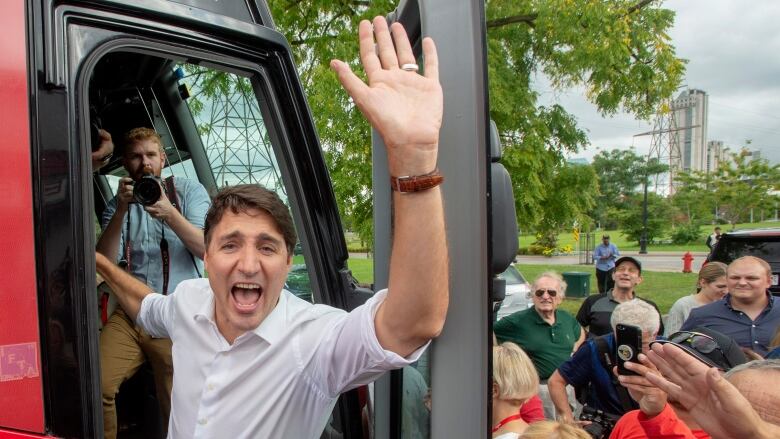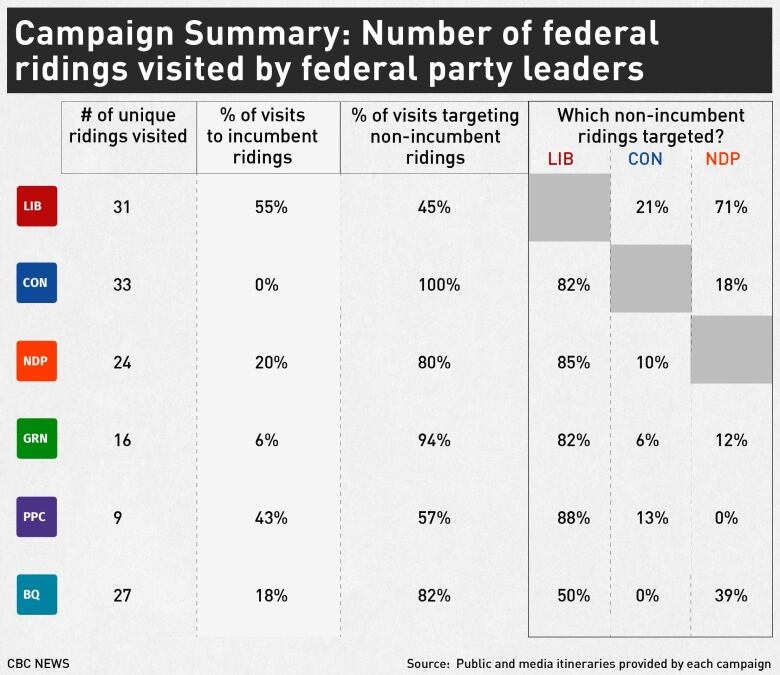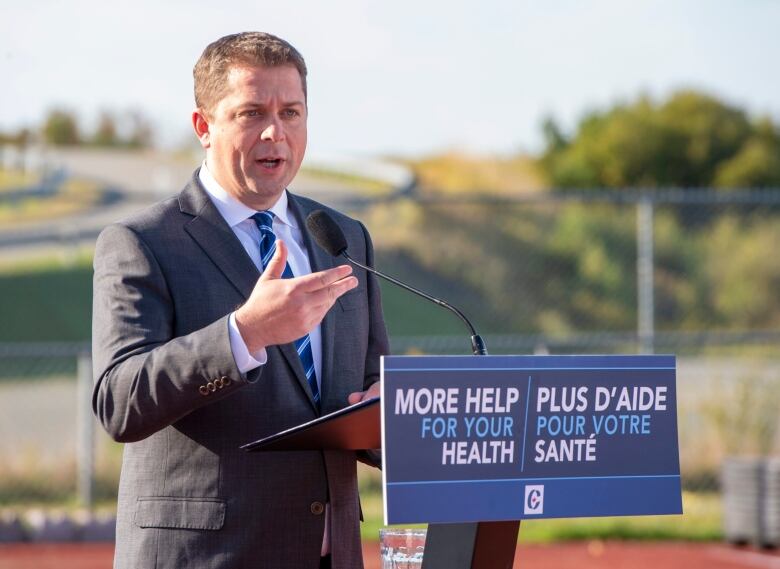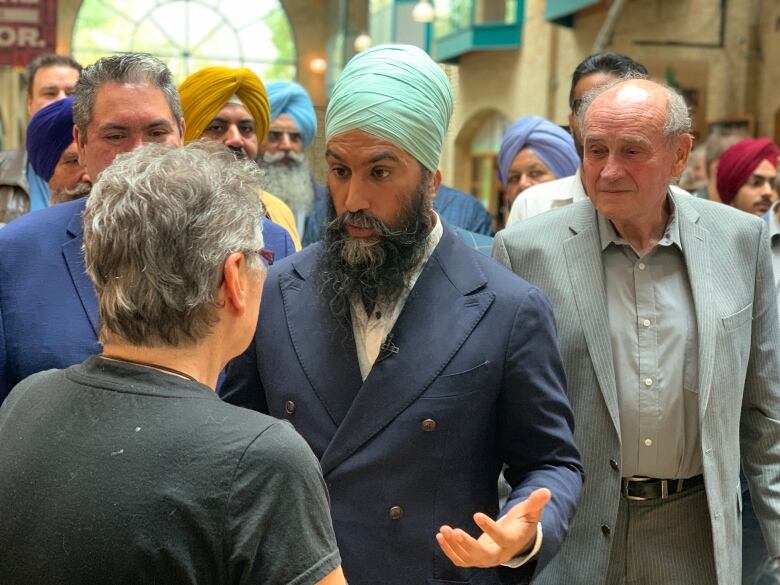To understand a party's election strategy, just follow the leader
Party leaders spent the first two weeks travelling the country - and revealing their electoral battle plans

If you want to know wherethe federal parties thinkthis election will be won or lost, you only need to look at where they've sent their leaders. Two weeks into this campaign, those hints are about as subtle as a flashing neon sign.
An analysis of each leader's tour schedule reveals that both the Conservatives and the New Democrats have been playing offence in the opening stages of the campaign, visiting ridings that were won by other parties primarily the Liberals in 2015.
And while Justin Trudeau is spending about half of his time in ridings where there is a Liberal incumbent, his trips toother ridings suggest that the Liberals see theirpath to re-election runningthrough ridings currently held by the NDP.
The leaders have been on the move since the writs dropped two weeks ago. Already, one-third of Canada's 338 ridings have received at least one visit from at least one party leader with Ontario and New Brunswick being the two provinces getting more than their fair share of face time with a leader.
Parties send their leaders to battleground ridings for a number of reasons. It gives the local campaign organization a morale boost andthe local candidate a higher profile and a leader's message can get a lot more attention in regional or local media.
So where have the leaders been so farand what does that tell us about their election strategies?
Liberals targeting NDP seats
According to a tracking of leader tours compiled by the CBC's Philip Ling, just over halfof Trudeau's visits have been to ridings wherethe Liberals are the incumbent party.
The number of riding visits Trudeau has made in Ontario, Quebec and British Columbia are roughly in line with each province's share of the country's population, though he has spent more time in Atlantic Canada and less in Alberta, Saskatchewan and Manitoba. This is in line with the geographic make-up of the Liberal caucus.

A lot of the Liberal incumbents hosting Trudeau are in ridings in the Greater Toronto Area and rural areas of Quebec and Atlantic Canada seats that are more likely to be at risk for the party.
But the ridings Trudeau has visited that are not ones the party won in 2015 are mainly held by New Democrats. By a margin of three-to-one, Trudeau is visiting more NDP ridings than ones held by the Conservatives.
They're NDP seats like Edmonton Strathconain Alberta, Trois-Rivires, BerthierMaskinong and LongueuilSaint-Hubert in Quebec and Windsor West in Ontario seats the Liberals want and need to win. Only a few Conservative seats have hosted the Liberal leader, and just one that was won by the Bloc Qubcois.
That suggests the Liberals see opportunity in the NDP's weakness. The Liberals know it will be difficult to avoid losses to the Conservatives, particularly in Atlantic Canada and the GTA. If they can make those up with gains at the expense of the NDP, they can still plot a course to a re-elected majority government.
Conservatives not playing defence
While the Liberals have sent their leader to seats the party won four years ago, the Conservatives have only been sending Andrew Scheer into enemy territory.
The Conservative leader has yet to make a campaign stop in a riding with a Conservative incumbent, suggesting that the party is only looking at where it can makegains.

By a margin of four-to-one, Scheer has visitedmore Liberal than NDP ridings. His stops have tended to be in Ontario and Atlantic Canada two key growth areas for the Conservatives at the expense of Quebec, Alberta, Saskatchewan and Manitoba.
The Liberal seats being targeted so far areprimarily in the Greater Toronto Area and in southwestern Ontario, while the few NDP ridings that have received a Scheer visit are in the northern part of Vancouver Island and in Quebec, where the party does have some prospect for gains.
The visits show the Conservatives aren't wasting time worrying about what they already have. They certainly have a lot of seats to pick up if they are to form a government and nearly all of those are seats that went Liberal last time.
NDPon the attack in Liberal ridings
For a party struggling in the polls, the NDPhas been sending Jagmeet Singh to a lot of ridings the NDP did not win in 2015. Nearly all of his stops, or 80 per cent, have been in these ridings and, by a margin of eight-to-one, they are Liberal seats.
Most of Singh's time has been spent in Ontario, though that can be explained partly by the fact the New Democrats began the campaign travelling by bus and only got their plane off the ground this week.

The Liberal seats Singh has visited are largely those the NDPwon in the past seats like BeachesEast York, Ottawa Centre and Sudbury in Ontario and Halifax and AcadieBathurst in Atlantic Canada. It suggests theparty wants to set itself up for gains later on.
The question is whether Singh will continue to play offence as election day draws near, or if he will start spending more time shoring up NDP support in seats the party held at dissolution. He's already visited vulnerable ridings like Sherbrooke and Saint-HyacintheBagot in central Quebec and Windsor West and Essex in southwestern Ontario as well as his own Burnaby South seat in B.C.
If he circles back to these, it might suggest the NDPis playing defence and abandoning hopes of gains.
Greens focusing on provincial success stories
With only two seats at dissolution, there are lots of other ridings for Elizabeth May of the Greens to visit. And that'swhat she has been doing though she hasn't often strayed far from where Greens have scored victories at the provincial level.

So far, her tour has largely been limited to B.C., Ontario and New Brunswick. She has spent a lot of time on Vancouver Island and B.C.'s Lower Mainland. She also has made two stopsalready in both Victoria and Guelph, ridings where provincial Green leadersin B.C. and Ontario have their seats.
Beyond these key targets, May also has visited ridings represented by provincial Greens, like Fredericton and Beausjour in New Brunswick and Charlottetown in Prince Edward Island. It shows that the Green strategy for this campaign is to turnprovincial wins into federal gains.
Bloc focusing on Montreal
Yves-Franois Blanchet of the Bloc Qubcois has spent most of his time in ridings that voted for the Liberals or NDP in the last election.
While Blanchet has made a few stops in Montreal and in central Quebec, his focus appears to be in the suburban seats around the island of Montreal, particularly to the south and east of the city. He also has visited many of the same ridings Trudeau has an indication that these two parties appear to be grappling for the same seats in Quebec.
Bernierkeeping it local
It's perhaps not surprising that Maxime Bernier is the leader who has held the most events in his own riding six, so far since it was the only riding he had at dissolution. Outside of his ownBeauce seat in Quebec, Bernier has been to New Brunswick, Ontario and elsewhere in his home province.
He has focused primarily on ridings where he has candidates withhigher profiles seats like Etobicoke North and NipissingTimiskaming in Ontario. He has also visited seats like Fredericton and MiramichiGrand Lake, ridings where the provincial People's Alliance (also populist, but unaffiliated with the People's Party of Canada) scored victories in last year's New Brunswick election.
Bernier is unlikely to have the same resources to travel the country as the other leaders. But all of them will spend the next four weeks crisscrossing the country. As they do, watch closely for the outlines of their strategies for winning the election or for avoiding disaster.
With files from Philip Ling














_(720p).jpg)


 OFFICIAL HD MUSIC VIDEO.jpg)
.jpg)



























































































